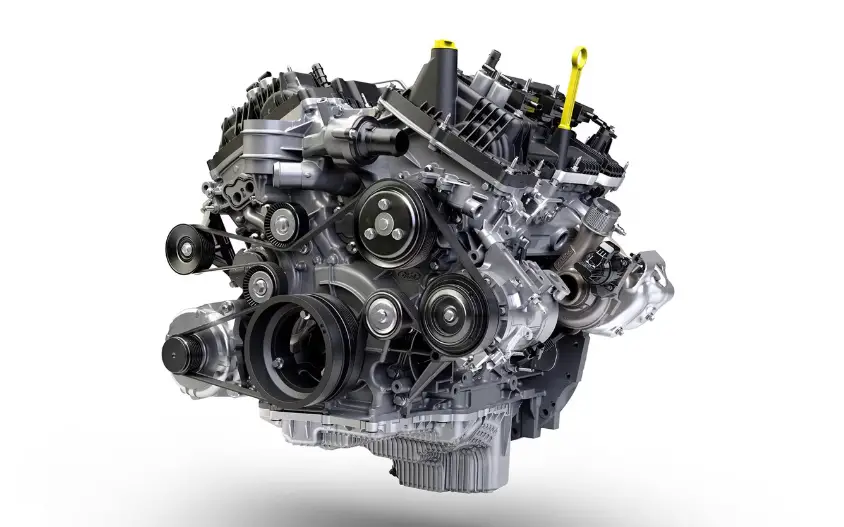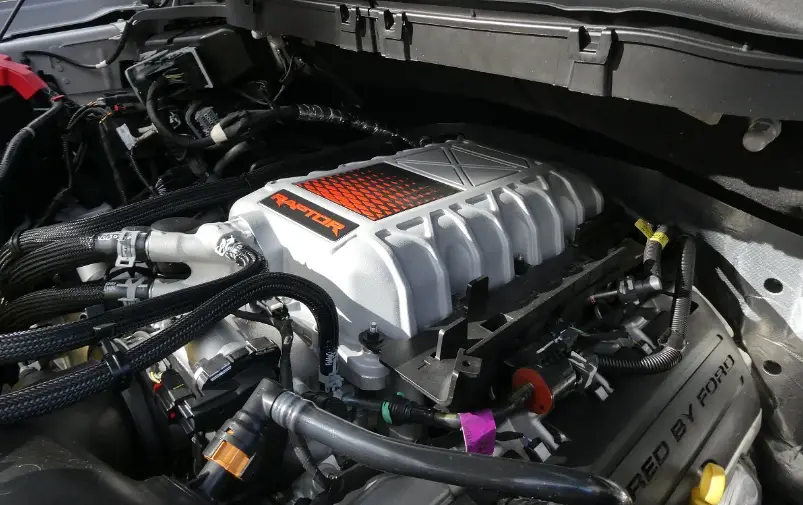The Ford Raptor offers a high-powered 3.5L EcoBoost V6 engine with 450 horsepower, ideal for off-road adventures. For extreme power, the Raptor R features a 5.2L Supercharged V8, delivering 700 horsepower. Both engines are built for rugged terrain, supported by advanced suspension and traction systems.
The Ford Raptor is a high-performance, off-road-focused truck, revered for its robust build, impressive power, and cutting-edge technology. First introduced as part of the F-150 series in 2010, the Raptor has consistently pushed the boundaries of what an off-road pickup can achieve. Designed to handle the toughest terrains, it has become a go-to choice for adventurers and performance enthusiasts alike.
This post delves deep into the engine specs, performance, and technological advancements in the Ford Raptor, specifically looking at its evolution from past models to the latest iteration.

Contents
- 1 Evolution of Ford Raptor Engines
- 2 First Generation: V8 Engines (2010–2014)
- 3 Second Generation: 3.5L EcoBoost V6 (2017–2020)
- 4 Third Generation: Enhanced 3.5L EcoBoost V6 and Raptor R’s 5.2L Supercharged V8 (2021–Present)
- 5 Technological Advancements and Performance Features
- 6 Ford Raptor Engine Comparison: Specifications Table
- 7 Frequently Asked Questions
- 8 Conclusion
Evolution of Ford Raptor Engines
Since its inception, the Ford Raptor has undergone significant changes, particularly in terms of its engine. Initially launched with a V8 engine, the Raptor transitioned to an EcoBoost V6 in 2017, leading to increased performance and fuel efficiency. Each generation brought new technology, enhanced durability, and improved off-road capability.
- First Generation (2010–2014): 5.4L V8 and 6.2L V8
- Second Generation (2017–2020): 3.5L EcoBoost V6
- Third Generation (2021–Present): 3.5L EcoBoost V6 with added enhancements; introduction of the Raptor R with a 5.2L Supercharged V8
Let’s take a closer look at these engines, examining what makes each unique and well-suited to the Raptor’s demanding performance requirements.
First Generation: V8 Engines (2010–2014)
The Ford Raptor’s journey began with V8 powerplants. Ford initially offered a 5.4-liter V8 engine, soon followed by a more potent 6.2-liter V8, providing an upgrade in torque and horsepower.
5.4L Triton V8 Engine
- Power Output: 310 horsepower and 365 lb-ft of torque
- Fuel System: Sequential multiport fuel injection
- Transmission: 6-speed automatic
- Fuel Economy: Estimated at around 13 MPG city, 18 MPG highway
The 5.4L Triton V8 offered sufficient power for light to moderate off-road excursions but was overshadowed by the more powerful 6.2L V8 option.
6.2L Boss V8 Engine
- Power Output: 411 horsepower and 434 lb-ft of torque
- Fuel System: Sequential multiport fuel injection
- Transmission: 6-speed automatic with manual shift mode
- Fuel Economy: Approximately 11 MPG city, 16 MPG highway
The 6.2L engine quickly became the preferred choice among Raptor enthusiasts due to its robust power output, enabling the truck to handle extreme off-road terrains and towing with greater ease. This engine set the standard for future generations, emphasizing power and capability.
Second Generation: 3.5L EcoBoost V6 (2017–2020)
In 2017, Ford introduced the second-generation Raptor with a new engine—the 3.5L EcoBoost V6. While some traditionalists were skeptical about moving from a V8 to a V6, the EcoBoost proved to be more powerful, efficient, and technologically advanced.
3.5L High-Output EcoBoost V6 Engine
- Power Output: 450 horsepower and 510 lb-ft of torque
- Fuel System: Direct and port fuel injection
- Transmission: 10-speed automatic
- Fuel Economy: Around 15 MPG city, 18 MPG highway
This engine featured twin turbochargers, providing the Raptor with significantly more torque than the previous V8 models, especially at lower RPMs—ideal for off-road performance. The 10-speed automatic transmission allowed for smoother shifting and improved fuel economy, balancing power with efficiency.
The second-generation EcoBoost V6 engine solidified the Raptor’s performance status, combining speed and agility with fuel-conscious engineering. It also introduced features like Auto Start-Stop Technology, which helped improve fuel efficiency by shutting off the engine when idling.
Third Generation: Enhanced 3.5L EcoBoost V6 and Raptor R’s 5.2L Supercharged V8 (2021–Present)
Ford took the 3.5L EcoBoost V6 a step further in the third-generation Raptor, improving the engine’s durability, cooling, and performance to better withstand high-demand conditions. In 2023, Ford released the highly anticipated Raptor R, featuring a 5.2L Supercharged V8 engine—catering to customers craving even more power.
3.5L High-Output EcoBoost V6 Engine (Enhanced)
- Power Output: 450 horsepower and 510 lb-ft of torque (similar to the second generation)
- Fuel System: Dual direct and port fuel injection
- Transmission: 10-speed automatic with improved torque distribution
- Fuel Economy: 14 MPG city, 18 MPG highway
While the output remains similar to the second-generation Raptor, Ford improved the cooling systems, added recalibrated dampers, and optimized the suspension system, making the third-generation Raptor more capable of sustained high-performance use. A new five-link rear suspension with longer coil springs provided better wheel travel and increased stability on rugged terrain.
5.2L Supercharged V8 Engine (Raptor R, 2023–Present)
- Power Output: 700 horsepower and 640 lb-ft of torque
- Fuel System: Direct fuel injection
- Transmission: 10-speed automatic, performance-tuned
- Fuel Economy: Estimated at 10 MPG city, 15 MPG highway
The 5.2L Supercharged V8, borrowed from the Ford Mustang Shelby GT500, makes the Raptor R one of the most powerful trucks on the market. With 700 horsepower, this engine is designed for those looking for maximum off-road performance, capable of rapid acceleration and extreme rock-crawling. The addition of the supercharger allows for rapid power delivery, making this version of the Raptor a true performance beast.

Technological Advancements and Performance Features
The Ford Raptor engines are supported by advanced technology aimed at maximizing performance:
- Terrain Management System (TMS): Ford’s TMS allows drivers to switch between various modes such as Mud/Sand, Rock Crawl, Baja, and Normal, each optimizing the engine, transmission, and traction control settings for different terrains.
- Trail Control: This feature works like off-road cruise control, allowing drivers to set a consistent low speed (up to 20 mph) while the Raptor automatically manages acceleration and braking.
- FOX Racing Shox: Every Raptor comes with high-performance shocks from FOX, designed to absorb impacts on rocky, uneven surfaces, and maintain stability on demanding trails.
- Torque-On-Demand Transfer Case: This technology automatically adjusts power between the front and rear wheels, providing optimal traction in unpredictable off-road conditions.
These technologies enable Ford Raptors to maintain a delicate balance between road and off-road performance, utilizing the engine’s capabilities to their fullest extent.
Ford Raptor Engine Comparison: Specifications Table
| Engine | Horsepower | Torque | Fuel Economy (City/Hwy) | Transmission |
|---|---|---|---|---|
| 5.4L V8 (2010-2014) | 310 hp | 365 lb-ft | 13/18 MPG | 6-speed auto |
| 6.2L V8 (2010-2014) | 411 hp | 434 lb-ft | 11/16 MPG | 6-speed auto |
| 3.5L EcoBoost V6 (2017-2020) | 450 hp | 510 lb-ft | 15/18 MPG | 10-speed auto |
| 3.5L EcoBoost V6 Enhanced (2021-present) | 450 hp | 510 lb-ft | 14/18 MPG | 10-speed auto |
| 5.2L Supercharged V8 (Raptor R, 2023-present) | 700 hp | 640 lb-ft | 10/15 MPG | 10-speed auto |
Frequently Asked Questions
Here are some FAQs about Ford Raptor engine specs –
1. What engine does the newest Ford Raptor have?
The latest Ford Raptor has an enhanced 3.5L High-Output EcoBoost V6 engine, producing 450 horsepower and 510 lb-ft of torque. The Raptor R variant, however, boasts a 5.2L Supercharged V8 engine, offering an impressive 700 horsepower and 640 lb-ft of torque.
2. Is the Ford Raptor available in both V6 and V8 configurations?
Yes. While the standard Raptor models feature a V6 EcoBoost engine, Ford reintroduced a V8 option with the 2023 Raptor R, powered by a 5.2L Supercharged V8.
3. How fuel-efficient is the Ford Raptor?
The standard 3.5L EcoBoost V6 Raptor achieves approximately 14 MPG city and 18 MPG highway. The Raptor R’s supercharged V8 has lower fuel efficiency, averaging around 10 MPG city and 15 MPG highway.
4. How much can a Ford Raptor tow?
The 2023 Ford Raptor with the V6 engine has a towing capacity of up to 8,200 pounds. The Raptor R with the V8 engine has a slightly lower towing capacity, around 8,000 pounds, due to its enhanced performance components.
5. What is the top speed of a Ford Raptor?
The top speed of the Ford Raptor varies slightly depending on the model but generally maxes out around 107 mph due to off-road-tuned gear ratios and power distribution settings.
Conclusion
The Ford Raptor’s engine lineup demonstrates Ford’s commitment to off-road power, performance, and engineering excellence. From V8 to turbocharged V6, and now a return to supercharged V8 in the Raptor R, each engine reflects Ford’s adaptability and innovation, making the Raptor a standout among high-performance trucks. Whether you’re tackling dunes, crawling rocks, or hitting the highway, the Ford Raptor is ready to deliver exceptional performance.